#death rebirth and the jackal
Text
Lockdown 2023
Dear Readers,
I’m sorry to say but I’ve just had to put everything on AO3 locked to signed in users only. I apologize in advance for the inconvenience it causes.
Why am I doing this?
Well, someone decided to copy and paste pages and pages of my work and then take another person’s work and copy and paste pages of their story, change a few names here and there, add maybe a couple of sentences, steal more sentences from a third person and well….
They said to a friend who pointed out that this was wrong that it was their right to do so because it was transformative and fanfiction is inherently plagiarism anyway, so it was alright for them to use my work as well as the other two writers.
They didn’t ask me if they could borrow my words.
They didn’t credit me.
They are matching up my version/headcanon of a character with someone that’s pretty much a NOTP for me at the worst of times and a dull side character with a weird romance option at their best. I don’t go here but everyone else is more than welcome to, just leave me out of it.
One of the other writers they took from is also a dear friend. They feel terrible that they tried to be friendly and welcoming someone to a small, niche fandom where a lot of us writers all vaguely know the others either through friends or friends of friends. Their welcome was taken advantage of and that really is almost worse than having my words taken without my permission.
I get that fandom has become more permissive of things like AI and assistive writing tools. I understand that all of us are in the process of becoming better writers through our writing—but I don’t stand for taking someone else’s words, copying them into a new document and then calling them your own, not giving credit or not bothering to link to the source. To me that is plagiarism. It’s not writing your own fic. It’s not transforming it into something better.
So, I’m putting my writing in the AO3 equivalent of tamper proof packaging. My words have already been stolen and it wasn’t even by something like an AI bot. This doesn’t feel like winning to do this—it feels almost antithetical. I’ve always had a policy that if you want to leave a critique or something negative you need to have your username attached but now I’m saying you can’t read it unless you’re signed in… which yeah.
This isn’t me winning. This is me trying to protect what’s left. I suspect it’s also useless to do so, but it’s the only option I feel I have.
I apologize to those that can’t access my works anymore. Please sign up for a free AO3 account—it’s worth it for more than just my writing. You can subscribe to authors/works in progress and make bookmarks—great benefits in my opinion.
Thank you for your time and for reading this,
Satashii aka satashiiwrites, 26th of May, 2023
#mass effect andromeda#mreyder#family familia ‘ohana#sleepless in la#eddie diaz ain’t ‘fraid of no ghost#the first spectre#bradley the damned#mana’olana#firefighter!derek au series#death rebirth and the jackal#an andromeda tale#the outlaw and the cartel boss#reinventing scott#promise me you won’t let me#all my other works not listed here#plagarism#AO3#my writing
11 notes
·
View notes
Text
The Other Symphonyxian Deities
Meet the other deities worshiped within the kingdom of Symphonyxia, also known as the Guardian Beasts!

Piana, Guardian Beast of Life
Name: Piana
Alias: Fox of Life & Rebirth
Race: Vulpine Great Beast
Gender: Agender (she/her, they/them)
Occupation: Symphonyxian Deity
Powers: Life manipulation, creation
Goal: Create new life and protect the balance between life and death
Allies: Fellow Great Beasts
Likes: Nature, tea, sleeping
Dislikes: Being woken up, people who disrespect nature, the undead
Themes: The Sleepy Fox - Piana’s Theme (Lion’s Theme)
Rebirth/Piana’s Battle Theme (Battle! Xerneas/Yveltal Piano)
The smallest of the Symphonyxian deities, Piana is a 50cm tall fox-like creature with silver and white fur, aside from her nine tails, which are multicoloured. A quiet and gentle soul, Piana is usually found napping within her domain: the Grove of Life - an endless forest full of flowers, trees, and little critters, with her usual nap spot being a tree stump in the centre of a sparkling lake. When she’s not asleep, Piana enjoys drinking tea. She finds the beverage fascinating as mortals combine many aspects of nature to create it. While asleep, Piana views new life being created in the mortal realms, and life’s final moments in real time. Despite being smaller than her siblings, Piana is the oldest of the main trio as she was created first, with the middle sibling being Tutti and Forten being the youngest. Like Tutti, she is a pacifist at heart and it takes a lot to anger her. But if she senses life being abused or destroyed unnecessarily, she will intervene. Do not underestimate this small deity as she has access to all life, calling on creatures to aid her and can manipulate the plants. She can also age life to the point where it’s on death’s door, but rarely uses this ability unless absolutely necessary. There are many tales and myths surrounding Piana, such as rainbows were formed when Piana danced across the world while creating life, that bountiful harvests were caused by Piana’s laughter, and that cuckoos are warriors of Piana who attack those that abuse nature. Piana claims the last one is very true.
Ancient Depiction of Piana:

~~~~~~~~~~

Forten, Guardian Beast of Death
Name: Forten
Alias: Jackal of Death & Decay
Race: Canine Great Beast
Gender: Agender (he/him, they/them)
Occupation: Symphonyxian Deity
Powers: Death manipulation, destruction
Goal: Oversee death, aid souls in reaching their respective afterlife, and protect the balance between life and death
Allies: Fellow Great Beasts
Likes: Sparring, organisation, sweets
Dislikes: Disorder, bright lights, those who disrespect life & death
Themes: The Orderly Jackal - Forten’s Theme (Higurashi Gou Main Theme)
Decay/Forten’s Battle Theme (Battle! Xerneas/Yveltal Rock)
Don’t let the dark, fierce apparent fool you! This 6'07", hexapedal jackal is anything but malicious. Forten is the fair, calm and mild-tempered deity of death, overseeing the death of all living things, and seeing that they arrive at their designated afterlife using the orb stored in his tail. Always busy dealing with departed souls, Forten rarely leaves his position within the River of Death, his signature domain. Despite his mature and composed nature, Forten is the youngest of the main trio. The story goes that Piana was born when the first living being came into existence, Tutti was born when it began to change and grow, and Forten was born when it stopped growing and withered away. Despite death regularly being vilified in the eyes of mortals, Forten bears no ill-will towards them, understanding loss can cause pain to mortals and that they just need time and space to accept it. He is quite close with Piana, who sometimes visits him in his domain, knowing he cannot leave his post, and respects her. While he occasionally butts heads with Tutti due to Timewalkers’ interference with timelines can cause excess death tolls and thus more work for him, he respects them and enjoys the rare times he hears from them. Less of a pacifist than his siblings, Forten won’t hesitate to jump into action if something is amiss within the mortal realms. While he can’t control when an organism is destined to die, he occasionally steps in when he feels a soul needs a “dose of karma”. There are not many tales of Forten with the existing ones being mostly negative. It is said that if you see a jackal before going into battle, it is Forten overseeing the fight. If it runs away, you or your side will win the fight. If it sits and watches you or runs across your path, your side will lose. On a funnier note (no pun intended), Symphonyxian musicians will usually curse Forten if they hit a flat note or go off-key during a performance. This tends to confuse Forten as he can’t see what he has to do with it, but lets it slide as he knows mortals can be “extremely strange”.
Ancient Depiction of Forten:
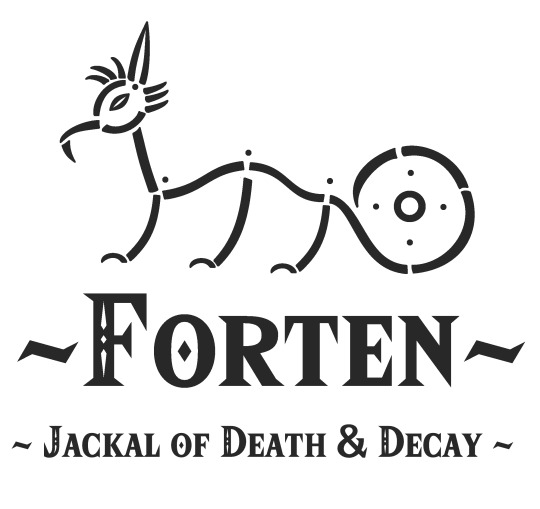
~~~~~~~~~~

???, the Original Deity
Name: ???
Alias: The Original One
Race: ???
Gender: ???
Occupation: Deity
Powers: ???
Goal: ???
Allies: ???
Likes: ???
Dislikes: ???
Little is known about this deity aside from the strange carvings that depict what looks like a tear-shaped gem. Some ancient tales state that there was once an ‘original deity’ that created the main trio. Nobody knows the deity’s name or what their the deity of. Some theories of what their domain might be are music, mortality, space, anitmatter, chaos, and reality. Despite extensive efforts from historians and archaeologists, there is little to no information on this deity. Dolcia once asked Tutti about this deity, who responded with “Honestly, even we don’t know. We never met the one who created us. We know they exist somewhere, but we’ve never found them or their domain. Whoever they are, they’ve made themself hidden and intend to stay that way...”
#legend of zelda#legend of zelda oc#loz#loz oc#age of calamity#legend of zelda age of calamity#loz age of calamity#cadence of hyrule#piana#piana fox of life and rebirth#tutti#tutti dragon of miracles and time#forten#forten jackal of death and decay#the original one#dolcia#princess dolcia
2 notes
·
View notes
Text
Deep dives into folklore: Egyptian mythology

Egyptian mythology is a rich and complex tapestry that weaves together a diverse pantheon of gods, goddesses, and mythical beings, providing insights into the beliefs and cosmology of ancient Egypt. The mythology of ancient Egypt spans thousands of years, evolving and adapting over different periods of the civilization's history. Here's a deep dive into key aspects of Egyptian mythology:
Creation Mythology:
1. Atum and the Ennead:
Atum, the primordial god, is often associated with the sunset and creation. According to some myths, Atum emerged from the chaotic waters of Nun and created himself.
Atum then produced the Ennead, a group of nine deities, including Shu (air) and Tefnut (moisture), who gave birth to Geb (earth) and Nut (sky).
2. Geb and Nut:
Geb and Nut, the children of Shu and Tefnut, were initially inseparable, but Shu raised Nut above him, creating space between them—representing the sky—and allowing life to flourish on Earth.
3. Osiris, Isis, Set, and Nephthys:
Osiris, the god of the afterlife and rebirth, ruled Egypt with his sister-wife, Isis. Set, another sibling, grew jealous and murdered Osiris.
Isis, the devoted wife, gathered Osiris's body parts, resurrecting him for a brief period to conceive their son, Horus.
The conflict between Horus and Set symbolizes the struggle between order and chaos.
Pantheon:
1. Ra:
Ra, the sun god, was a central figure in Egyptian mythology. He traveled through the sky during the day and navigated the underworld at night.
Ra's journey through the underworld and rebirth at dawn mirrors the cycle of the sun.
2. Horus:
Horus, often depicted with a falcon head, was associated with kingship and protection. The Pharaohs were believed to be the earthly embodiment of Horus.
The Eye of Horus symbolizes protection, healing, and power.
3. Thoth:
Thoth, the ibis-headed god, was the scribe of the gods and the inventor of writing. He played a crucial role in the judgment of the deceased in the afterlife.
4. Anubis:
Anubis, the jackal-headed god, presided over mummification and guided souls through the afterlife. He weighed the hearts of the deceased against the feather of Ma'at during the judgment in the Hall of Ma'at.
Afterlife and the Duat:
1. Duat:
The Duat was the realm of the dead, a mysterious and perilous place that the deceased had to navigate to reach the afterlife.
2. Ma'at:
Ma'at, the goddess of truth, justice, and cosmic order, played a crucial role in the afterlife judgment. The heart of the deceased was weighed against the feather of Ma'at.
3. Osiris and the Afterlife:
Osiris became the ruler of the afterlife, offering the possibility of eternal life to the deceased who passed the judgment in the Hall of Ma'at.
Rituals and Beliefs:
1. Mummification:
The process of mummification was a vital ritual to preserve the body for the afterlife. Organs were removed, and the body was treated with natron before being wrapped in linen.
2. Book of the Dead:
The Book of the Dead was a collection of spells and rituals designed to guide the deceased through the afterlife successfully.
3. Temples and Cults:
Temples were dedicated to specific gods, and cults practiced rituals and ceremonies to honor and appease the deities.
Egyptian mythology reflects the Egyptians' deep connection to the natural world, their preoccupation with the cyclical nature of life and death, and their profound religious beliefs. It served as a foundation for their societal norms, rituals, and the concept of an afterlife. The stories of gods and goddesses, creation myths, and the pursuit of balance and order continue to captivate and inspire curiosity about this ancient civilization's spiritual beliefs.
Taglist (reblog or reply to be added):
@axl-ul @crow-flower @thoughts-fromthevoid @alderwoodbooks @harleyacoincidence @tuberosumtater @sonic-spade @theonlygardenia @holymzogynybatman @nulliel-tres
#writeblr#writers of tumblr#writing#bookish#booklr#fantasy books#creative writing#book blog#ya fantasy books#ya books#Deep dives into folklore#folklore#egyptian mythology#egypt#ancient egypt#mythology
23 notes
·
View notes
Text
The Importance of Worshiping Egyptian Gods and Goddesses in the Modern World

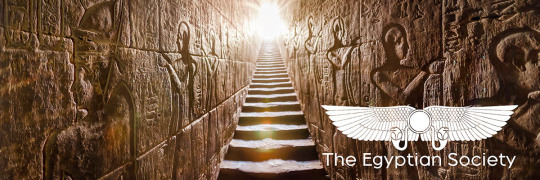




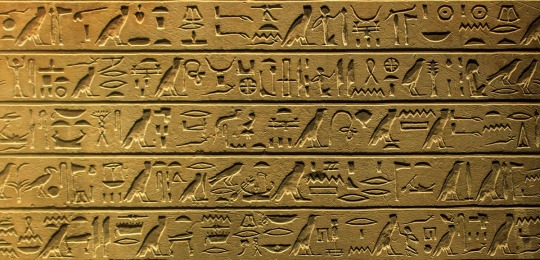


The Importance of Worshiping Egyptian Gods and Goddesses in the Modern World
The Egyptian Society: Anubis ‘God of the Afterlife’- Oracle: Andrew Rogers
“Hello my name is Anubis I look after the dead and all funerary practices when you die you travel to me and have judgement on your life this is important, it is important that you lead a good life so when you are judged upon death you transcend to the afterlife, in ancient times I was worshipped quite widely and there was much to do people feared me, in the modern times things are different after Egypt was taken over by its enemies then the process noted in the Book of the Dead was ceased, new religions came to the force and a lot of history was lost, but I still undertake my responsibilities each day. I am interested in the modern people who worship the Egyptian Gods and Goddesses and are aware of the Book of Dead, it is extremely important that we have the modern person worshipping and learning about the Egyptian Gods and Goddesses, be careful in life and be love, practice daily and we will meet when you journey to the location of your afterlife” Anubis ‘God of the Afterlife’
Anubis, the God of the Afterlife, continues to fulfill his sacred responsibilities, even in these modern times. Although the worship of ancient Egyptian deities has diminished over the centuries, there are still individuals who honor and study the teachings of the Egyptian Gods and Goddesses.
While Egypt has faced various challenges throughout its history, including foreign invasions and the rise of new religions, Anubis remains steadfast in his role as the overseer of the dead. The ancient practice of judgment after death, as described in the Book of the Dead, may have faded away, but the significance of leading a virtuous life remains paramount.
Anubis seeks to connect with those who are familiar with the knowledge preserved in the Book of the Dead. Their understanding of the Egyptian pantheon and their dedication to learning about the ancient ways is crucial. By embracing love and practicing daily, these modern followers ensure a future meeting with Anubis when they embark on their journey to the afterlife.
Let us remember Anubis, the guardian of the dead, and appreciate the importance of spirituality in our lives. May we all strive to live virtuously and be mindful of the ancient wisdom that Anubis embodies.
Anubis ‘God of the Afterlife’
Anubis, the jackal-headed god of ancient Egypt, has fascinated people for centuries with his mysterious role as the guide of souls into the afterlife. From the First Dynasty to the Middle Kingdom, Anubis played an important role in Egyptian society as the god of embalming, weighing of the heart, and ushering of souls into the realm of the dead.
Despite being one of the most ancient and frequently depicted gods in the pantheon, Anubis played almost no role in Egyptian myths. However, his significance was far-reaching, as he represented the power of death and rebirth, and his black color symbolized the discoloration of the corpse after embalming as well as rebirth.
Anubis was often associated with Wepwawet, another god portrayed with a dog's head or in canine form, but with grey or white fur. Together, the two figures were believed to have guided and protected the deceased on their journey to the afterlife.
Anubis also had a female counterpart, Anput, and a daughter, Kebechet, who was the serpent goddess of purification. The myths and legends surrounding Anubis may have faded over time, but his enduring presence in Egyptian culture is a testament to his importance and influence on ancient beliefs and practices.
Anubis' image can be seen in various ancient Egyptian art forms, including reliefs, sculptures, and paintings. His iconic canine head, black fur, and slender body make him instantly recognizable. Anubis was an integral part of Egyptian funerary rituals, and his presence ensured that the dead received proper burial and were guided to the afterlife.
Despite not having a significant presence in Egyptian mythology, Anubis remains one of the most iconic and recognizable figures from ancient Egyptian culture. Today, his image is often used in popular culture, from movies to video games and even tattoos. It just goes to show the enduring legacy of ancient Egyptian beliefs and practices, and the lasting impact they have had on the world.
The Egyptian Society
Andrew Rogers: Founder, Egyptian Auteur, Creative Director, Writer, Oracle
All images, text, design, and art license owner Andrew Rogers©.
#ai#andrewrogers#auteur#destroyer#egypt#egyptian#egyptianauteur#godofdeserts#godofthesun#instruction#Anubis#AnubisGodOfAfterlife#EgyptianBeliefs#KemetianSociety#BookOfTheDead#OracleWisdom#EgyptianAuteur#MotivationFromAncientEgypt#InspirationFromAnubis#QuoteFromAndrewRogers#LeadAGoodLife#Egypt#Egyptian#Ra#Sekhmet#Set#AndrewRogers#TheEgyptianSociety#Motivation#Instruction
14 notes
·
View notes
Text

The Sirius Gateway July 4-8 ~
Every year during the first week of July, a sacred gateway of energy is activated between Earth and the star Sirius, bringing heightened vibrations and spiritual advancements.
This gateway of energy occurs as the Sun comes into conjunction with the star Sirius, which is located at 14 degrees of the tropical zodiac of Cancer.
As the Sun and Sirius conjunct from July 4-8, we are all able to access this high-frequency energy and use it for creative inspiration, entrepreneurial endeavors, technological innovations, and heightening our intuition.
Sirius has long been revered by many ancient cultures and is considered our Spiritual Sun.
Our Sun is considered the lifeline of this planet.
The Sun holds the energy of birth, warmth, sustenance, and light.
The Sun is what keeps us alive and present in this Earthly reality.
Sirius, which shines 23 times brighter than our own Sun, is our “Spiritual Sun,” and it helps to activate and shift us to higher levels of spiritual awareness.
If the Sun our Earth orbits warms our body, Sirius, way out in the depths of our galaxy, warms our soul.
Even though the star Sirius is so far from our planet, it seems to have an important place in the stories of many ancient cultures from all over the world.
In Ancient Egypt, Sirius was considered to be the star of the Goddess Isis, who rules over the cycles of death and rebirth, and Anubis, the jackal-headed God, who was able to walk between the world of the living and the world of the dead.
In ancient Shamanic cultures, Sirius was believed to be a portal to the Gods, and journeys taken through the Sirius Gateway were said to bring Divine messages.
It was also believed that Sirius was the portal to heaven, and was where our souls had to travel through in order to leave this realm and enter the next.
It seems that for many ancient cultures, Sirius aligns with the idea of spiritual awakening, and the inevitable cycles of transformation that occur as we make our way through this Earthly journey and beyond.
In modern astrology, Sirius also holds the vibration of freedom.
Its energy can help us to release limitations and feel free to express our true selves.
This energy of freedom can also act as inspiration, helping us to go out there and turn our goals and dreams into reality.
Sirius is also believed to be home to an alien race that possesses extremely advanced technological innovations and psychic abilities.
While there are many starseeds that already feel connected to Sirius, at the time of this gateway, it may become easier to receive messages from Sirian beings or perhaps remember past or parallel lives from Sirius.
All of this energy high-frequency energy makes the first week of July a highly potent time on Earth, where we can open and advance our spiritual awareness, receive messages from the Divine, and find a new freedom within ourselves and our lives.
It is also a time where we may find ourselves more open to connecting with higher beings, and honoring our own cycles of death and rebirth and how they have helped us to advance spiritually.
In order to receive this powerful spiritual energy in your own life, the first week of July would be the perfect time to meditate, activate your third eye, and to reach out to your spirit guides, guardian angels, or higher self for guidance.
It would also be the perfect time to do an aura cleanse and work on finding more freedom in your creative or entrepreneurial projects.
If you work in technology, you may feel extra supported with any innovations you may be working on or you may receive a sudden burst of inspiration.
Forever Conscious
Art: fultonhobbs
31 notes
·
View notes
Text
stranger things daemon au (part 1: the party)

mike and sophronia
as i dont really think about mike much, i haven't really thought about it much, but i feel like she'd settle somewhere during the events of s1, possibly after. most of the daemons, especially the kids' daemons, settled due to trauma. but considering mike's relationship with his himself, i feel like she'd have struggle settling. if any of you have a better idea for what his daemon would be, i'd love to hear why and i might implement it in a fic or two :)

will and althea
no, he's not a raven! he's a pheonix, but when her and will aren't... yk, dying, or when althea isn't regaining her feathers from dying, she's black. his daemon would 100% settle during the upside down. another option i had on the table was the dudu deer. i thought a pheonix would fit more as they stand for renewal and rebirth, but i deers would also be symbolic for will, especially how they're considered feminine, so it could be even more reason for the town to think he's gay. i prefer pheonix but they're both good picks!
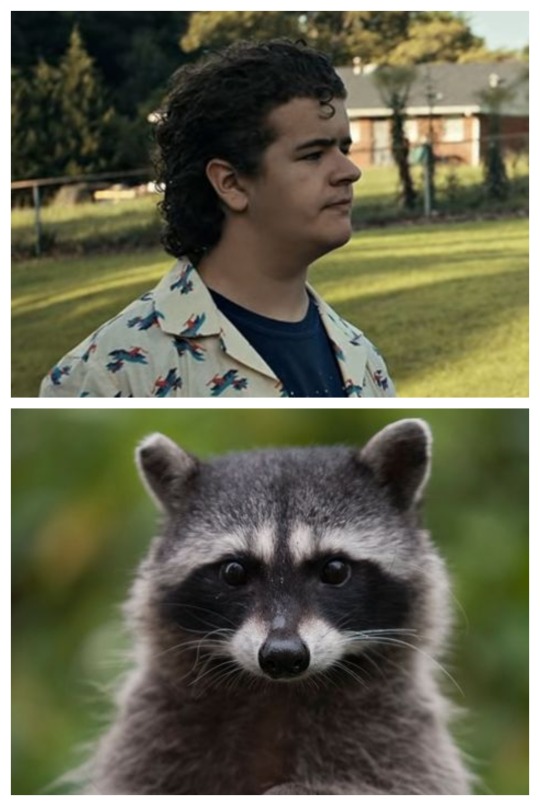
dustin and syretia
(syretia pronounced sigh-ree-sha)
syretia flits from form to form, changing a lot just as dustin does. during season 1, while in school, she usually stays in small forms to avoid getting targeted by bullies, forms that can fit in his pocket, usually some kind of mouse. while with the party, she usually goes into a monkey form because they're tinkerers and like having the extra hands. and while at home, she usually stays as either a beagle or switches between domestic cat breeds. in season 2, she's slightly overcome her fear of getting bullied, starting to perch on his shoulder as a bird or follow his heels as a cat. when fighting, she changes into the biggest form she can manage - a jackal, somewhat imitating steve's delmira. in season 3, she's much more comfortable in larger forms, usually monkeys or even a few different lizards. in season 4, she goes back into smaller forms, but still sticks with something bigger. when eddie dies, however, she finally settles. she's a raccoon, and doesn't speak as much as she used to, even though she always said she'd boast whenever they would settle.

lucas and fidelia
a groove billed ani for lucas. i have a feeling he'd settle second earliest of the boys, after will. fidelia had been gravitating towards bird forms for a while, and then they saw this bird while researching what daemon forms mean in a school project, and the form just... stuck. he got a lot of flack for it, especially as he's already bullied for being black. lucas takes it better than he probably would've done before he found out about the upside down, but he still wishes that fidelia had changed into something that didn't look so much like a crow or raven, both with bad reputations. she likes matching with will after althea regains her feathers, though.
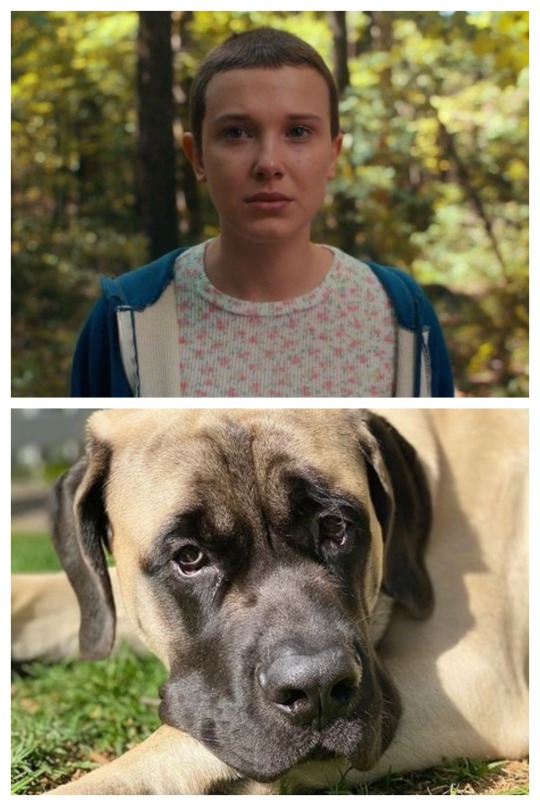
el and amias
el and amias's relationship is a little complicated. taken and immediately seperated at birth, amias is locked in the cells where the other kids' daemons are, and she doesn't find out what a daemon even is until she meets mike, dustin and lucas. she only manages to reconnect with amias - who'd been named K, the eleventh letter - at the end of season 2, when she returns to the lab to close the gate, and is named by hopper's daemon. i feel like amias wouldn't settle for a LONG time, especially as people's expectations of her keep on changing. amias settles after max's death and subsequent revival, but even though everyone says you're supposed to understand yourself more after you settle, el just feels more lost.
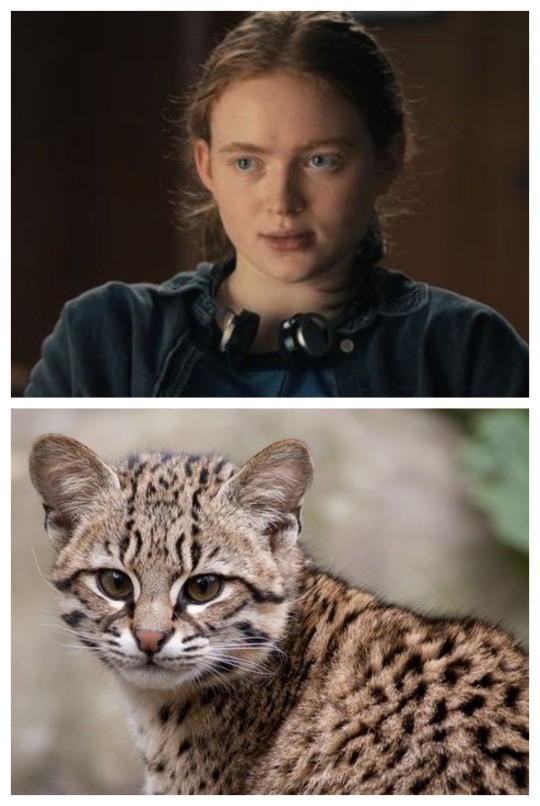
max and hercules
in my version of the au, hercules has heterochromia (because it looks cool) and a torn ear (because of billy) no matter which form he takes. he's always liked furry forms max can curl up with because they're both deprived of warmth so often, but before he settled, he used to sometimes turn into a bird to match fidelia, or a dog to chase syretia, or a maine coon to annoy sophronia. but as they ran into the main part of the mall, only to freeze at the sight of billy and ulysses fighting back against the monster, hercules shifts into the small cat form, cowering against max's legs. when ulysses, whose powerful jaw has bitten him and whose large claws have given him scars, falls to the ground, hercules can't bring himself to get close to her, opting to stay cowered to the ground, trembling and scared. this is what hercules and max feel most guilty about, that they weren't able to 'comfort his soul' at the last moment, despite how much they've both tormented them over the years. their relationship grows slightly more rocky as the months pass, and by s4, they don't talk as much as they used to, and max often digs her nails into hercules's fur, of course hurting herself too, although she tries to stop this because she doesn't like hurting him, even though he feels like he deserves this.
will do the teens next, i love them <3
#mike wheeler#will byers#dustin henderson#lucas sinclair#el hopper#max mayfield#daemon au#stranger things daemon au#byler#lumax#elumax#stranger things#stranger things 4#st4#stranger things 3#st3#stranger things 2#st2#stranger things 1#st1#btw just to make it very clear i hate billy hargrove with a vivid passion /srs
45 notes
·
View notes
Text
BOTW 2 TEARS OF THE KINGDOM FIRST IMPRESSIONS

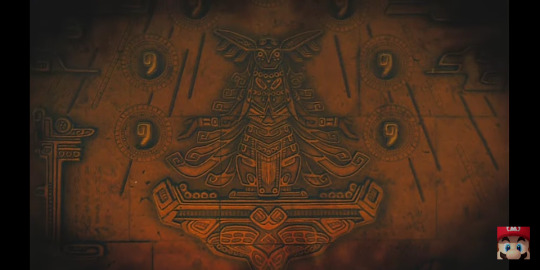
Divine Beast? At first I thought it kinda looks like Naboris fused with something else? Kinda also looks like a Jackal. Kinda reminds me of Anubis, Egyptian god of the Dead, which would fit with the Ouroborus theme of death & rebirth. Could this be a Shiekah or Zonai God/Deity? Are the Zonai & Shiekah connected?
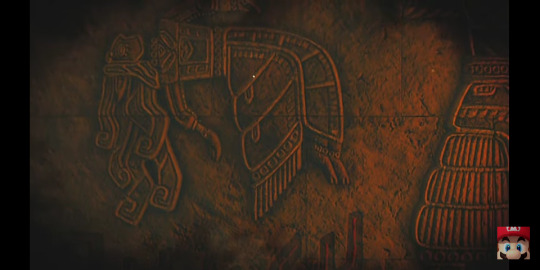
What the heck is going on here? Looks like someone is being possessed? Princess Zelda/Hylia?

I think this is the musical instrument we usually see in Zelda lore.

Is this... Is this skyloft??
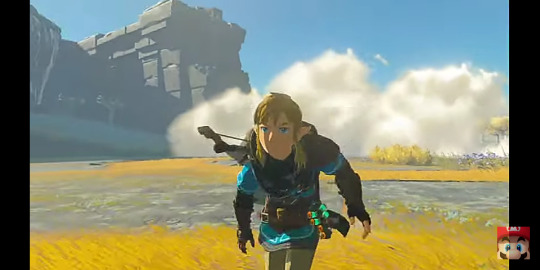
Notice the green thingies in place of the Shiekah Slate??

Looks like a Shiekah Slate rune, kinda looks like Stasis when u whack a rock upwards. Like an elevator of some kind?
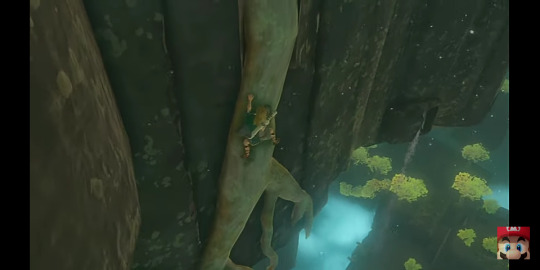
Y'all. It's snowing here and he is climbing. WEATHER CLIMBING. Also wondering if this game is not open air, because he is climbing solely on the tree root? Or maybe the root has better traction for climbing during weather?
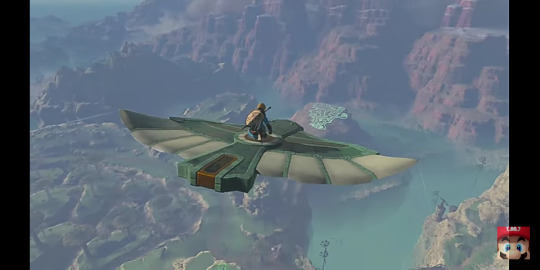
I wonder if this replaces the paraglider? Also, what is that green mark on the ground?

Ouroborus. The Snake that devours itself. Symbolizes destruction & rebirth.
#zelda#tloz#botw#botw 2#tears of the kingdom#zelda tears of the kingdom#totk#the legend of zelda#nintendo#breath of the wild#zonai#ganon#divine beasts
56 notes
·
View notes
Note
fuck. dude. ok. i want to talk about symbolism for a second and i want to talk about the subversion of archetypes in the use of symbolism.
archetypal significance of water is typically life and rebirth, cycles, etc. water is what keeps us alive, the cycle of the ocean, its use in religion etc etc etc okay we get it.
archetypal significance of the desert and its associated components is typically hot and inhospitable, dangerous and desolate. people die there. skeletons and cactus and heat and NO WATER.
okay now i want to point out how these typical afchetypes and associations are turned on their heads.
steven and the circle of sand around his bed- symbol of protection. its a safeguard and a signal to himself and it gives him a sense of security.
marc is brought back to life as moon knight in the desert. His desth isnt as signuficant as the fact that he was brough back. He gets the suit and he gets it in the desert and its safety and .its life.
the duat. marc going back for steven. another instance of rebirth happening in the desert. its acceptance and its connection and its a new way of living.
ok see how the symbol of the desert and sand is established as life? ok cool.
Marcs brother roro drowns. he dies in water. it traps him and kills him.
when theyre in the tomb the body is shot and it falls backwads into water. they die in water.
the first time we see the moon knight suit is in the bathroom when marc kills the jackal. it dies surrounded by burst pipes and water.
i think theres something to be said about how the moon controls the tides as well.
something something water represents the big overwhelming feelings that marc has and the guilt he carries and khonshu takes that and uses that against him
when khonshu tries to talk to layla he cant convince her because her emotions and her problems arent drowning her in the same way they do marc and i think marc was drawn to that in her as well
this might be totally incomprehensibke but i needed to get it out. anyway. thoughts?
Read that first paragraph and started actually vibrating in my gd seat. Do you know who you're talking to. DO YOU.
THEN I STARTED READING THE REST OF IT AND SENT MYSELF INTO HYSTERICS.
I find it so genuinely fascinating how this show has taken these common archetypes and just.. flipped them on their head while still connecting the concepts in a way that portrays a more complicated idea.
I love everything you've brought up here. While the desert was a much more apparent theme throughout the show, the symbolistic intent of water was more ambiguous, kind of in the background but absolutely intentional and threaded throughout if you really picked up on it.
As far as the moon controlling the tides, you could interpret this as the moon controlling death. And that's the fearful thing about being Moon Knight and living by that arrangement. It's what he stands for, in a way. Khonshu exists as an omnipotent force, his avatar a weapon he wields to dole out his judgement on whomever he sees fit. The avatar has no choice in the matter, doesn't and can't influence the decisions a god makes like the moon can't change it's effect on the tides. While Khonshu is a ruler of his moon, his moon is avatar, the tool that controls the oceans, a tool to be used. It fits with Marc's pattern of being used by those he seeks purpose in, and his desire to be useful.
Another idea I've considered, and I hope I'm not hijacking your analysis here because I know we were talking about subversion, are the ties between another two common archetypal meanings: water as a symbol of rebirth and purification and the desert as an absence of growth and development. Because as long as Marc stays tied to a god of the desert, the more his life stays the same. He continues to be surrounded by death and devastation, enabling the cycle of destruction that's followed him since he made Khonshu his promise. He remains stagnant. The catalyst of this, the moment he diverts this pattern and breaks the cycle, is when Layla tells him in the tomb, you have a choice. And he makes it, this choice leading him, finally, to his loss of the suit, the dissolution of his promise. This is the moment he finally leaves the desert.
As far as rebirth and purification, I think of the moment he and Steven are resurrected, pulling themselves from the same waters they died in. There's the obvious interpretation of them coming back to life at that moment, clawing their way back into the world, but it's not just that. It's the fact that, before this, back in the Duat, they've become balanced through learning their truth, and that's what brings them back. Marc has been, to some degree, relieved of his burdens, his guilt. Steven his confusion, his misunderstanding. While they haven't completely lost these things, they've cleansed them in a way that they're easier to carry. That they can live in the world anew, with a different perspective. And, so, been purified.
#i love symbolism i love digging and searching for thematic connections#this was such a lovely deep dive thank you for just#absolutely bowling me over with it#woah nelly this became a lot i'm so sorry#i just#i love this show so much#blipityblopityyy#asks#mk meta#moon knight#holds up that tiny sign in crayon again that says 'story analysis is my passion'
110 notes
·
View notes
Text
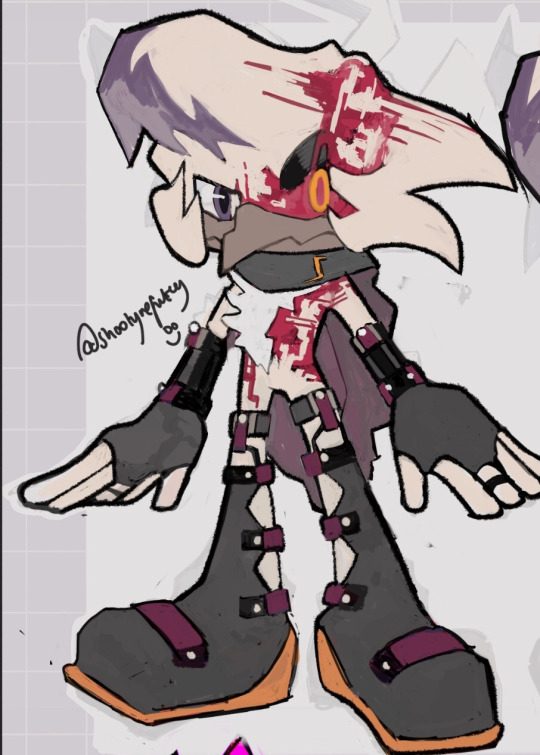
Since idk when I’m gonna get the reference done, here’s Canter the Dove
Lore and info about her:
In my fanfic, she was the first victim of Infinite. Whilst in the fic she stays dead, in an AU she is resurrected by Eggman using the sheer power of the phantom ruby. Whilst normally it cannot be used on the dead, an insane amount of energy is used to try and bring her back. Just to see if he can. After realising the impossible logistics he gives up after though.
Once the final battle with Eggman is over and the phantom ruby powered Death Egg robot is destroyed, Eggman’s base is left completely deserted. Storm the Albatross has been separated from his friends the whole time and managed to stumble across a base. Without guidance from his boss, he doesn’t really know what to do. He’s a pretty strong fella and managed to break through a strangely very reinforced room, only to find Canter, still strapped up and hooked to a phantom ruby infused IV line that had run dry.
At first, Storm believes her to be a ghost and is absolutely terrified of Canter. Especially because Canter soon found herself being visited by the same Jackal that killed her, except he was much more bitter, spiteful and self loathing. Turns out because the ruby power source was destroyed, and Infinite had been sent off to power the ruby in the final battle, Infinite’s soul had nowhere else to go except be tethered to the last remaining vessel of the ruby. Only Canter could see and talk to him, and he looked pretty worse for wear and was definitely not happy to be stuck in essentially purgatory. He got nicer over time though.
(Storm and Canter are also dating but I haven’t figured out that part yet.)
Canter has been granted powers due to the phantom ruby’s strong presence within her, and for the first few months of her rebirth she could actually use them. In my AU, the ruby amplifies your strongest emotions. While Infinite’s powers centered around exposing others’ fears due to him being deeply insecure and living in constant fear, Canter makes people feel a wave of desolation and nothingness. Whilst Infinite’s power manifested in cubes, Canter’s is a red mist. Upon waking from Eggman’s base, she felt nothingness, meaning that her powers could manifest. But after a year or so of living a normal life, her powers began to fade. Besides, it hurt her to use this power and she had no use for it, so therefore she never used it. Sometimes she’d feel the power come back, but it took a lot of willpower to drive it away.
She is the brother of Aster, and they have only spoken once. That was Canter asking him where to find Eggman.
28 notes
·
View notes
Text

Egyptian Gods & Goddess
Aker: God of the Earth and horizon, protection.
Bastet: Goddess of protection, takes the form of a lioness or a cat.
Anhur: God of war and hunting
Bat: Cow goddess of the sky
Anubis: God of the dead, conductor of souls, has the head of a jackal
Hathor: Goddess of the sky, sun, sexuality, motherhood, music and dance, the afterlife
Bennu: God of the sun, rebirth, and creation
Geb: God of the Earth, physically supports the world
Horus: God of the sky, sun, protection, kingship and healing
Khepri: God of the morning/rising sun, has a scarab beetle had a face
Montu: God of war and the sun
Nefertum: God of the lotus flower and youth
Nemty: Falcon god, Ferryman for the gods
Osiris: God of death, resurrection ‚rebirth, ruler of the underworld
Ptah: God of craftsmen and creation
Ra: Ruler of all Gods, god of the sun, god of creation and afterlife
Set: God of deserts, storms, violence, disorder and foreigners
Shu: God of the air, wind and supporter of the sky
Thoth: God of the moon, writing and seribes, master of physical and moral law.
Wadj-Wer: God of the sea and fertility
Imentet: Goddess of the afterlife, friend of the dead
Isis: Goddess of motherhood, protection, and magic
Kauket: Goddess of chaos and darkness
Maat: Goddess oftruth, justice, and order
Menhit: Goddess of war, foreign war, took the form of a lioness
Neith: Goddess of creation and hunting, patron of the city Sais
Nekhbet: Vulture goddess, goddess of protection
Nepit: Goddess of grain, counterpart to Neper
Nut: Sky goddess, arched over the heavens
Pakhet: Lioness goddess, goddess of war.
Sekhmet: Goddess of destruction and violence, warded of disease, protector of Pharos,consort of Ptah.
Wajdet: Cobra goddess, protective of earth and Pharos.
#witch#witchblr#witchcraft#baby witch#magick#occult#witchy#beginner witch#kitchen witch#moon#ancient egypt#egypt#moon magick#pagan witch#witchcore#cottage witch#green witch#witches#witch community#baby wiccan
12 notes
·
View notes
Text
Death, Rebirth and the Jackal, Chapter VII: At Odds
Whew. Only 2 months past my original deadline….
Title: Death, Rebirth and the Jackal, Chapter VII: At Odds
Fandom: Mass Effect Andromeda, The Mummy (1999) with influences from Moon Knight, American Gods and other various bits of Egyptian-themed media, borrowing of Egyptian Myth
Pairing: MReyder. Past Reyes/Zia
Fic Summary: The Jackal wakes when his master returns.
Chapter summary: Reyes and Zia have a less than friendly tete a tete.
Tags/warnings: not an exact fusion of The Mummy (1999). Zia should be a warning. Werecreatures. The gods walk among us. Alternative universe.

Read chapter VII here on AO3
#death rebirth and the jackal#chapter update#mredyer#mredyer fic#reyes vidal#scott ryder#mass effect/the mummy AU#the mummy 1999#abuse of Egyptian mythology#other influences from american gods and moon knight
10 notes
·
View notes
Text
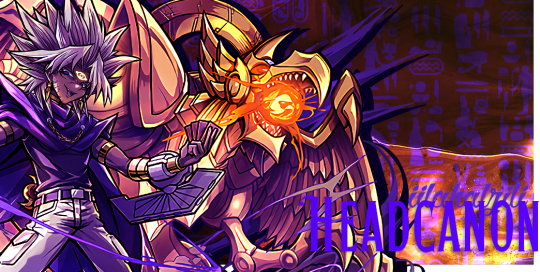
The Son of Ra's tomb is intricate, yet also incomplete due to the suddenness of the followers' deaths. It contains multiple false rooms, traps, pits, treasure rooms and of course, the inner tomb. The main statues are of Ra and Anubis, both in full human-animal form as well as falcons and jackals. Majority of the walls are made of black stone and the inner tomb has any symbols covered in a film of gold. There are many symbols of rebirth, prayers to the Son of Ra, and the protection of the god's soul to ascend to the plains with the gods--and primarily symbols of the winged scarab. Oddly, within the inner tomb, there are lines speaking of a "God of Shadows" creation--something many overlooked. . . Above the sarcophagus is a large carving of the Winged Dragon of Ra, the guardian.
Marik's memories of the tomb's construction is limited, the shadows destroying most of it due to the fact they do not want the Medjay to be released. Because of the curse placed upon the tomb after Marik's defeat // death to ensure he could never escape, the shadows had taken all but the good in Marik's soul ( the part that clung to the Gift of Ra ), and left the physical body behind--the separation of the soul and the shadow. If the tomb was to be opened and the body reunited with the Medjay, there would be a high chance of Medjay and Shadow meeting.
Some of the spirits of his closest followers ( ie General(s), Advisor, High Priest etc ), remain in the tomb ( although some may have perhaps reincarnated ) , to protect from any robber who dares try to break in.
Due to his claustrophobia and cleithrophobia, Marik is highly unlikely to enter the tomb himself ( also considering the terrible memories he has ), and the fact there is the high possibility that it will cause the completion of his soul and returning to the Son of Ra rather than the God of Shadows. Although, he does desire to get back his spear, khopesh and bow.
#❛ ɴᴏᴛʜɪɴɢ ꜱᴀᴛɪꜱꜰɪᴇꜱ ʙᴜᴛ ʏᴏᴜʀ ꜱᴏᴜʟ ❜ ☾ • ☼ headcanon // about#(✨world building✨)#(Ra loves doing it)
2 notes
·
View notes
Text
Charnel Ground and Pure Land
Quotes from https://vividness.live/charnel-ground and https://vividness.live/pure-land, both from David Chapman’s Vajrayana Buddhist blog Vividness. Undated, but probably posted somewhere circa 2010.
Charnel Ground
Tantra offers no salvation, no escape, no alternative, and no hope. Now that’s scientific, pragmatic, and sensible. [...] But existential optimism—“there must be a way out”—makes things worse than necessary. You waste effort chasing imaginary salvation, and keep feeling hurt when it doesn’t work out.
Tantra has an antidote.
It is a “practice of view,” which means developing the habit of interpreting the world in a particular way. Specifically, you view the world as a “charnel ground.”
Charnel grounds, in India, are places where unclaimed human corpses are dumped to rot, or be eaten. The bodies are not buried or burned; they are just left out. That’s a delightful buffet for the local carrion-eaters: jackals and hyaenas, tigers and bears, vultures and ravens. [...] Unburied corpses also attract demons—in the Indian imagination—and are likely to produce ghosts and vetalas (zombies).
Sane, decent people avoid charnel grounds absolutely. That makes them ideal meeting places for dangerous, marginal people: brigands and spies, for instance, according to lore. Also dakinis (cannibal witches) and yogis (sorcerers): that is, tantric Buddhists.
Reality is a dangerous, horrifying, chaotic place. No one gets out of here alive.
We want to pretend that isn’t true. Most of the time, we convince ourselves that things are going tolerably well, and will get better, and death is remote. We have hope for the future.
Then we are surprised, and unprepared emotionally, any time something bad happens. [...] So let’s cut that right off: there is nowhere you can go where you won’t find monsters feasting on piles of rotting corpses.
The entire universe is a charnel ground. It extends to infinity in every direction: across space, time, all dimensions. There was no glorious creation, no golden age of the past, no possibility of salvation in the future. If there are any alternate worlds, spiritual planes, or magical states of consciousness—they are also entirely charnel ground.
The point of viewing all reality as a charnel ground is to annihilate existential hope: the hope that you can somehow win the game; the hope that you can somehow escape; the hope that Buddhism will somehow rescue you from old age, sickness, and death. [...]
It’s easy to misunderstand the method of charnel ground: “Oh, I get it! What a wonderful, paradoxical path to enlightenment! If I just fully embrace hopelessness, then I will be saved!” That is, of course, just more hope.
The charnel ground—i.e., everyday reality—is not a hell. [...] The difference is not in the degree of suffering. Some Buddhist hells might be less bad than some lives in the real world.
The difference is that the inhabitants of hell are so busy feeding their rage that they see no possibility of curiosity, creativity, or celebration. [...] Some of the hells are so lethal that the whole process only takes a few seconds per rebirth. So beings die in hell over and over, for countless eons, because they keep getting angry about the whole thing. If you just drop that, then you go somewhere else next time you die.
When you accept that it extends to infinity, you realize that the claustrophobic charnel ground—exactly because there is nowhere else—is a land of total openness and freedom.
You can set off in any direction to explore the scenery. The geography is endlessly varied. There are lakes of fire, rivers of poison, and oceans of blood. There are forests of cannibal trees, and of course the Nameless Lurking Evils at the Mountains of Madness.
Instead of trying to escape: You could have fun compiling an atlas. You could throw a party. You could invite the zombies. [...] You could write a geeky identification guide to the many species of demons. You could grow a garden of poisonous flowers. You could learn alchemy and refine poisonous herbal extracts into magical potions. You could go talk to the cannibal witches. They’re unusual company. They might eat you, but something else could happen. Romance is possible…
Pure Land
That is the tantric practice of “pure vision.” [...] What is important is relating to people as though they were Buddhas, and relating to circumstances as though they were a “Pure Land.” [...]
Nothing is objectively “ordinary,” and nothing is objectively “sacred.” These are strictly in the eye of the beholder. So which would you prefer to live with? [...] The physical world is nirvana. You should want to be connected to it, as much as possible, because it is thoroughly enjoyable, and because the real world is the place you can be most useful.
In pure vision’s paradise, nothing is unsatisfactory or threatening. So, you can relax. There’s no need to categorize people and situations as good, bad, or uninteresting. [...] Pure vision makes everything interesting—not “good.” Interest is what makes everything enjoyable. [...]
Tantra offers salvation from samsara after all!
Nope.
[...] the ultimate aim of pure vision is not to see anything that isn’t objectively there, nor to hide anything that is. The aim is to end the hallucination that subjective valuations (good, bad, uninteresting) are objective qualities. [...] There is a powerful social taboo that says you are only allowed to enjoy “good things.”
The pure land might sound like heaven, but it’s actually quite different.
Traditional Buddhism has heavens, which it considers no damn good. Everything is so blandly pleasurable that you turn into an indolent idiot. There is no motivation to do anything but soak in it. [...] You can spend billions of years without noticing that you have got absolutely nothing done.
A pure land, by contrast, is the ideal place for Buddhist practice. It’s comfortable enough that you can settle into meditation, but not stupefyingly pleasant. It’s varied enough to jolt you out of the mindless bliss states that can trap advanced meditators. In the pure land, the point is to wake up, train hard, and learn how to make yourself useful.
In heaven, it is always 78 degrees Fahrenheit—a soothing tropical warmth. In the pure land, there are bracing autumn mornings that say: wake up!
In heaven, angels play constant sweet songs. In the pure land, there is none of that kitschy muzak. There is silence—often the best thing for meditation. In that, you may hear the sound of wind in the branches. As dusk falls, frogs call. There is the croak of a raven; and then in the distance the snarl of a hyaena. [...] So in the pure land, the hyaena’s snarl is a useful reminder that time and life are limited, which motivates practice.
Heaven is a garden of perfectly maintained, tastefully color-coordinated flower beds, emitting a delicate perfume.
There are flowers in the pure land, too. They grow on thorny black brambles, amidst the heaps of rotting corpses, which emit the acrid stench of death.
Wait a minute! Something’s wrong—this suddenly got twisted and weird…
What went wrong?
Nothing. Here is the secret key to both practices:
The pure land is the charnel ground.
The charnel ground is the pure land. [...]
All of reality is always simultaneously a pure land and a charnel ground.
Everything is sacred—perfect just as it is. Everything is a nightmare, horror heaped on horror.
The charnel ground is a paradise: there are always plenty of corpses to eat, and rivers of poison to drink. [...] Everyone you meet is a shambling undead monstrosity and also a perfectly enlightened Buddha.
[...]
In the garden of nightmares, coiling vines grow pale flowers. They bloom at midnight.
You stroll through the endless charnel ground hand-in-hand with the god/dess of your dreams.
S/he stoops and, delighted, picks up a bleached, broken human femur. It glints in the moonlight.
You turn it over in your hands, admiring the delicate filigree of bone within. So lovely!
5 notes
·
View notes
Text

The Egyptian Book of the Dead, also known as the Book of Coming Forth by Day, is a collection of ancient Egyptian funerary texts written on papyrus scrolls. Dating back to the New Kingdom period, the Book of the Dead served as a guidebook for the deceased on their journey through the afterlife, assisting the soul in navigating the perilous realms of the underworld and achieving eternal life among the gods.
The Papyrus of Hunefer is one of the most well-known and well-preserved examples of the Book of the Dead. It dates to the 19th Dynasty of ancient Egypt (circa 1292–1189 BCE) and is named after its owner, Hunefer, a scribe and nobleman. The papyrus is a lavishly illustrated and meticulously written scroll, spanning multiple meters in length, and contains a wealth of religious and funerary texts intended to guide Hunefer's soul through the journey of death and rebirth.
In the Papyrus of Hunefer, the scene of the "weighing of the heart" is one of the most iconic and significant depictions found. In this scene, the deceased individual's heart is weighed against the feather of Ma'at, the goddess of truth, justice, and cosmic order.
Symbolism:
- The heart: In ancient Egyptian belief, the heart was considered the seat of the soul and the repository of a person's thoughts, feelings, and actions during their lifetime. It represented the individual's moral character and integrity.
- The feather of Ma'at: Ma'at's feather symbolised cosmic balance, harmony, and truth. It served as the standard against which the deceased's heart was judged.
- Anubis: The jackal-headed god Anubis is depicted as overseeing the weighing process. As the god of the afterlife, Anubis plays a crucial role in guiding the deceased through the journey to the afterlife.
- Thoth: The god Thoth is often depicted alongside Anubis, recording the results of the judgment. As the god of wisdom, writing, and magic, Thoth serves as a scribe and mediator between the living and the dead.
Meaning:
- The "weighing of the heart" scene symbolizes the judgment of the deceased's moral character and conduct during their lifetime. It represents the belief in divine justice and the accountability of individuals for their actions in both life and death.
- The outcome of the judgment determines the fate of the deceased in the afterlife. If the heart is found to be in balance with Ma'at's feather, the individual is deemed worthy of entering the realm of the blessed and enjoying eternal life in the presence of the gods. However, if the heart is heavy with sin and wrongdoing, it is devoured by the monstrous creature Ammit, and the soul is condemned to cease to exist.
Overall, the scene of the "weighing of the heart" in the Papyrus of Hunefer encapsulates the core beliefs and values of ancient Egyptian funerary religion, emphasizing the importance of moral integrity, cosmic balance, and divine judgment in the journey to the afterlife. It serves as a potent reminder of the eternal quest for righteousness and the enduring hope for spiritual salvation in death.
#egyptian art#book of the dead#papyrus of Hunefer#the mystic gallery#art#artistic interpretation#artistic journey#artistic tradition#symbolism
0 notes
Text
Egyptian Gods

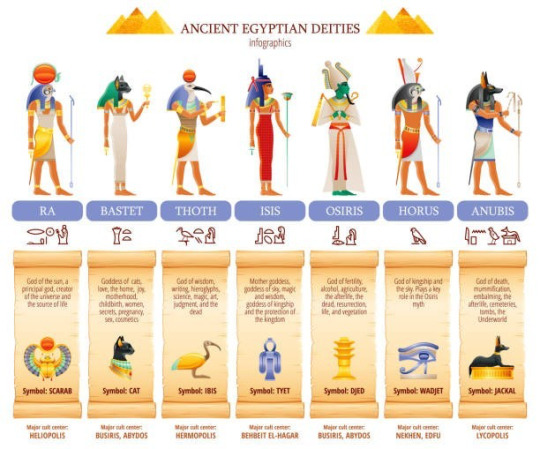
Ancient Egyptian mythology, with its diverse pantheon of gods and goddesses, offers a captivating glimpse into the religious beliefs of one of the world's earliest civilizations. Among the prominent deities, Anubis stands out as an iconic figure. Depicted with the head of a jackal, Anubis played a crucial role in funerary rites and the afterlife. He was the guide of souls and oversaw the solemn ceremony of weighing the heart, determining the fate of the deceased in the afterlife.
Ra, the sun god, held a central position in Egyptian mythology. Revered as the supreme deity in many periods, Ra represented creation, warmth, and light. Osiris, the god of the afterlife and resurrection, symbolized the cyclical nature of life and death. Osiris played a central role in Egyptian mythology, embodying the hope of rebirth after death.
Isis, the powerful goddess of motherhood and magic, played a vital role in the resurrection of Osiris. Horus, with the head of a falcon, was the god of the sky and kingship, often considered a protector of the ruling pharaoh. Thoth, the god of wisdom, writing, and knowledge, maintained the balance of the universe and was associated with record-keeping.
Bastet, depicted with the head of a lioness or a domestic cat, symbolized home, fertility, and protection. Hathor, associated with love and beauty, was also linked to music, dance, and joy. The worship of these gods was integral to Egyptian religious practices, manifested through elaborate temples, rituals, and ceremonies that sought to honor and appease these divine entities.
The mythology surrounding Egyptian gods reflected the intricate spiritual beliefs of an ancient civilization that held profound reverence for the cycles of life, death, and the promise of an afterlife. These deities were not merely distant figures but integral to the daily lives and cosmic understanding of the Egyptian people, shaping their worldview and influencing cultural practices for centuries.
0 notes
Text
youtube
Song of the day
(& the month*)
Set (Mackenzie / Kenny-Smith / Cavanagh / Craig / Harwood / Walker)
Snout of a jackal and a tail of a snake
Slithers and slinks through the desert, awake
Gorges on moonbeams and bathes in quantum foam
Unchallenged in the infinite unknown
Tornado bore down and lifted him high
Throwing Set around with a windy cry
His bones did shatter and his flesh did rend
But still, the god did not bend
Osirus of Geb, of Nut and dead, dutifully did what he was beset
Slay the mighty Set…
Governs sandstorms with but a gesture
Squeezing day into night with supernatural pressure
God of duality and king of the fight
Right eye the sun and left the moon's light
His followers screamed
His enemies cheered
As they watched their golden god disappear
Be unto your storm with a final breath
Set, it’s time to meet your death
Osiris of earth, of sky, and birth
Cut the cord Kill the king and reset
Slay the mighty Set…
The god of death and rebirth too
Out with the old and in with the new
Ashes to gashes
The past of new life is made
Brightened up the shadows
Light up the shade
Horus gave Set the downstairs snip, snip
Poked out his eyes and ripped it to pieces
Eighty years of conflict
Crocodile-dog-birth
Lucifer inverted
Slender usurper
Piece of work
Struggling stranglehold akin to poison and going for broke
An eye for a sun
And an eye for the moon
Love letter death threats written in the tomb
The seed is set
Cow-horn-headdress
The seed is set
Hieroglyphic
Slay the mighty Set…
(*until Oct. 27th at least)
0 notes